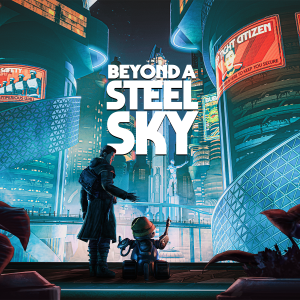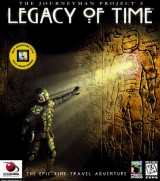Review for Beyond a Steel Sky

Game information
Adventure Gamers Awards
I’m sure you remember when you first saw your favorite movie or first listened to your favorite song, and the joy that experience gave you. I had those emotions as a 1990s teenager when I first played Beneath a Steel Sky, the 1994 science fiction point-and-click adventure from Revolution Software set in the bleak dystopia of Union City. It was then, and remains today for me, the most fully realized sci-fi world ever created in a traditional adventure, and its expert balance of serious dialogue with droll humor, as well as memorable voice work, visual design and music earned the game its status as a cult classic and my favorite adventure game of all-time—and one, it seemed for decades, that was destined to be one and done.
The first hope of Robert Foster’s return to Union City came in 2004, when Revolution director Charles Cecil stated that the studio had “started to move forward” on a sequel. Then five years passed with only occasional mentions of their continuing interest, but nothing specific. The open-source freeware release of the original in 2009 again fueled speculation that good news was coming, and in 2012 came a somewhat serious announcement that the next game had been green-lit—followed yet again with nothing but the odd indication of interest as Revolution’s focus remained solely on the Broken Sword franchise. . .until an extraordinary day in 2019 when dreams became reality: Beyond a Steel Sky was a real game with a real date. After a few final delays to keep us all on pins and needles, that date is finally here and a sequel twenty-six years in the making has arrived. While the game will appeal most to the series’ dedicated fanbase, it is a worthy modern adventure in its own right that doesn’t simply imitate its predecessor, and is one that is sure to be embraced by classic adventure fans and newcomers alike.
The story takes place ten years after the events of Beneath a Steel Sky. Union City’s transformation from oppressive dystopia to upbeat utopia, which began at the conclusion of the last game, has been accomplished. Now, instead of a dangerous industrial fortress, the heart of the city more resembles New York City’s Times Square, with holo-advert banners electronically promoting the welfare of citizens (helpfully tended to by the Ministry of Wellbeing, one of five Ministries that oversee the activities and daily lives of its citizens). Events take place on Aspiration Day, an annual holiday celebrating the recent history of Union City, complete with an evening gala—but only for those who have a high enough social standing. LINC, the computer system that controlled society a decade ago, is a relic of the past, replaced with MINOS, the new network that controls all robots and automated systems within the city.
Foster has long since returned to the Gap, the rough desert territory outside the boundaries of Union City. His lovable sidekick Joey remained behind, and is now celebrated as a near-deified figure. Foster is happy and content until the kidnapping of a Gap child named Milo, and his pursuit of the kidnappers leads him to the body of a Union City citizen named Graham Grundy. Foster must get back into the city to find and rescue the boy, but the U-Chip technology implanted in each citizen prevents a Gaplander like him from entering undetected—so the only way for him to infiltrate the city is to assume the dead man’s identity. Of course, in a world where government oversight is omnipresent, it doesn’t help that the real Grundy was a slightly out of shape sanitation worker already flagged for attention, and whose Qdos score—a constant letter-grade barometer of each citizen’s fitness and societal ranking—has dropped precipitously. As a consequence, he is not entitled to receive an Aspiration Brooch, the accessory given to Social Climbers that allows access to certain areas that will be essential to Foster’s quest.
The mission takes players to a variety of locations, from the main piazza landing area to the apartment home of your new Graham Grundy persona, and to places like a bleak and dangerous recycling facility as you progress deeper into the heart of the city’s dark secrets. What is first understood to be an isolated kidnapping and one lonely corpse becomes something much more sinister, and ultimately leads to a very surprising final sequence as the entire mystery is revealed. Before arriving at this ending, the story does not always move with the same momentum as its predecessor, which is understandable since it’s not the blank slate who-am-I-really type of identity mystery that the first game was centered around—but along the way there are some important character revelations, and one dramatic moment that carries significant emotional impact and left a pretty substantial lump in my throat.
Beyond a Steel Sky is built using the Unreal engine with a 3D direct control style, using either a gamepad or (my preference) WASD with mouse-look. As you walk around, small circles develop on nearby characters or items that you can interact with, which when centered allow you to click and choose from available verbs (usually just Examine, Talk or Inventory). The actual walking feels a little too slow at times given how large the settings can be, so I suspect many will be leaning on the run key most of the time while thinking that an always-run toggle option sure would have been nice. There are lots of characters to talk to, with dialogue sequences consisting of selecting from as many as six topics, some of them multiple times. You may receive additional information from the same topic three or four times until the subject label indicates there is nothing else to be gained from revisiting it.
You will accumulate a small collection of items over the course of your adventure, but other than the first hour of the game, inventory is very much an afterthought. Instead, the focus of the puzzling is on the MINOS hacking device that you acquire very early on. Right-clicking at any point while walking around calls the device up in Foster’s hand and identifies any type of automated system nearby that can be hacked. The interface for this is about as simple as could be: a series of large shapes that identify the if/then routines assembled together in a way that resembles a model you’d use to teach a young child their first lesson about coding.
These puzzles are generally fun and rewarding when you figure them out. A very simple one involves a VIP lounge door. As currently programmed, if the citizen (as determined by their embedded U-Chip) is eligible for the lounge, the door is opened. If not, it’s left closed. Since your Grundy persona is certainly not a VIP, how to fix that? Easy, just change the parameters of a couple routines and walk on in. Even better is that the game is great about applying consistency of logic beyond just the immediate puzzle solution, such as the very humorous situation that takes place after your hack when an actual VIP tries to leave the lounge and finds that he’s now trapped by your switch of routines. Many hacking puzzles involve transferring, moving an entire routine or dataset between devices, creating not just one unexpected repercussion but two, impacting a variety of people with each.
Some of the hacking puzzles get more in-depth with extra steps, sometimes transferring an action or modifier—a smaller chip embedded in routines that alters the way in which the action is performed—across multiple devices. One challenge involves moving a modifier from a janitorial robot to a certain museum exhibit, but they are too far apart to be simultaneously hacked—so you’ll need to find a way to bridge that divide to complete your task. There are multiple modifiers in more than one exhibit throughout this museum affecting how the displays communicate their message (Gently, Excitedly, Aggressively, etc.) and they can all be switched and applied to other exhibits or robots, often with really entertaining results that can be totally missed if you’re focusing on rushing through the game.
This mechanic comprises a substantial part of the gameplay; especially in the second half, there are essentially only two actions you’ll take—hacking and talking. The inventory becomes less and less of a priority, and since there are few items collected and no ability to combine them, there’s not a lot of difficulty, especially compared to the previous game. There’s even one moment where, instead of using an inventory item on an animal to attract it, all you do is select the animal and the verb Lure is available, making the game’s disregard for traditional inventory even more apparent. While hacking is a cool idea and allows for some really entertaining extra interactions, it eventually starts to feel repetitive when it really seems like there’s nothing else to do. There are also a couple occasions when failing to react to the environment can lead to your death, but these are completely fair and telegraphed (yes, when a robot gun turret tells you that you have ten seconds to move, you should do so), and if you do die, you are almost instantly warped back to a few moments earlier to get yourself out of harm.
For those who struggle with how to approach the hacking puzzles, Beyond a Steel Sky features one of the best in-game hint systems I have ever seen, almost a perfect implementation of the popular Golden Age hint books. From the main menu, clicking on “Reveal Hint” below your current objective will first give you only a very vague idea about how you should approach the task. You can continue to the next hint, but only after waiting out a 30-second timer—and you can spend that half-minute either screaming at the game for being unfair (as my young son almost certainly would if he were to apply his Fortnite patience level) or, as I did, you can actually think about the general hint you just received and where it should lead your thought process. The game often doles out four or five hints for any given objective, each pushing you a little further toward the solution before reaching the “do exactly this” clue. I doubt that many players will need to use this feature very much; your next goal is almost always clear if you pay attention to the dialogue, use basic intuition, and take the time to explore your environment and carefully look at things.
And why wouldn’t you want to look at everything? Beyond a Steel Sky is a remarkably attractive game, with the outdoor expanse of Union City stretching in all directions and simply awe-inspiring to look at. The first game, as a 2D pixel art adventure, was hardly a visual powerhouse with the majority of its scenes set indoors; here the towering vastness of this futuristic metropolis surrounds you, and with the full 3D power of Unreal Engine 4, it’s just remarkable. Dave Gibbons, the renowned comic book artist famous for Watchmen, among others who collaborated with Revolution to design the previous game, has returned as art director and rather than pushing everything to hyper-realistic graphics, he makes the sequel look exactly like the cool sci-fi graphic novel it aspires to be. Standing in the midst of the piazza, surrounding by flashing banners, announcement droids (or d-RYDs, as they’re now called) giving banal reminders of city rules, greeting terminals, and all sorts of inconsequential citizens walking around and speaking to others, it is truly a feast for the senses. The world feels alive and immersive and just incredible to absorb.
The soundtrack is much more restrained, always present but generally providing only light ambience suitable for a science fiction background, except during key cutscenes, including the brilliant ending, when the music steps up to a fully orchestral cinematic score. The voice acting is also uniformly excellent—an impressive feat given the amount of conversation. The protagonist’s voice is very different from the original game, more professionally acted and a little older and softened—not surprising given the ten years Foster has aged between adventures. The other human characters are also enthusiastically performed and generally bear the weight of the more serious and dramatic aspects of the game, but the real stars are the d-RYDs, who nearly outnumber the humans in this world. From Chipworth, your cleaning servant d-RYD; to Tarquin, the butler with a flair for the dramatic; to the squeamishly positive robot manning the Aspiration Brooch kiosk; to the homicidal security d-RYD preventing you from reaching the inside of a crucial industrial facility, they are all perfectly cast, and their dialogue is brilliantly sharp and consistently hilarious, a perfect modern update of the British-leaning humor that Beneath a Steel Sky became famous for.
Then, of course, there’s Joey, maybe the greatest non-rabbit adventure sidekick ever created. Though not a constant presence throughout the game, whenever he comments on the world around him, inserting his snide little one-liners, there’s nothing you can do but smile. You can even repeat earlier conversations with others while he is accompanying you, and when they bring up the famous Joey he will pipe in with some type of sarcastic remark.
Unfortunately, the unusual last-minute, out-of-nowhere nature of the game’s release date is even more odd given that there is a pretty noticeable need for additional polish. While only a couple bugs actually have the potential to be game-breaking (and autosaving is frequent so there is unlikely to be any real frustration or loss of effort), there are unusual graphical glitches, errors during observed NPC conversations where only one character’s lines are visible, plentiful problems during dialogue sequences where a camera appears stuck in a close-up of a wall instead of properly displaying the speaking character, and a rather hilarious bug where NPCs will walk over you if you’re in their way—literally, they will step up onto the top of your head and back down to the ground and continue on their straight line. You’d think that a game this long in the making, and with no actual launch date ever announced until the surprise Apple Arcade debut, could have used another few weeks of QA—though at least Revolution has already identified some of these and other minor issues for what will hopefully be a quick patch.
Those admittedly minor polish issues aside, Beyond a Steel Sky succeeds so well because it balances the importance of creating a contemporary adventure game that looks and sounds sufficiently modern with the need to appeal to fans of the franchise. This sequel consistently references events from its predecessor, brings back supporting characters in surprising ways, and features one particular return to one of the most memorable areas from the original, complete with an updated version of the distinctive background music. I can’t even find words to describe my joy in playing that sequence, returning to a perfectly new version of a place I never thought I’d go back to. I never wanted to leave.
Indeed, that was my general impression playing through this game, which is likely to take 10-12 hours for most players: I didn’t want to leave. I had a story to finish and a review to write but, even though this is a linear game without side quests or a vast open world to explore, I just wanted to keep walking around, looking up at the majestic city surrounding me, reading the comic speech bubbles of NPCs walking past each other, looking at the holo-adverts, and listening to all the d-RYDs making their announcements. And it’s worth taking the extra time, as there are little touches throughout that can easily be missed, such as gaining access to Graham Grundy’s personal terminal and emails, which add all kinds of humorous color and interesting details about his life and personality, none of which are necessary to complete the game. Despite the underlying troubles that make this seeming utopia subtly ominous, it is a beautiful and immersive world, fully realized once again with impressive attention paid to the details. This isn’t a long game by modern AAA game standards, but it’s one I would have been happy to spend double the amount of time in, even though I likely saw and interacted with nearly everything available.
It’s hard to put a numeric score onto something that brings you personal joy, even for someone who’s been writing reviews for two decades. There’s no question that Beyond a Steel Sky isn’t perfect due to its lack of puzzle diversity and technical polish issues, and while the story is compelling, it doesn’t reach the heights of the first game’s. Yet for a jaded old gamer who holds the original in such high regard, this long-awaited return was largely an overwhelming blast of joy, a delightful second visit to one of the best settings ever created in the genre, at a time in our own world when I most needed something to be joyful about. The sequel balances nostalgia with modern sensibility, reuniting many timeless characters from 1994 with an array of new ones, each unique and flawlessly acted. And even during the most unsettling and even tragic moments, I found myself smiling and wanting to give this game a hug. Your mileage may vary if you have no knowledge of or affection for Beneath a Steel Sky (though since the game is free to download, there’s no reason not to check it out), but for everyone else, I can assure you that twenty-six years later, the return to Union City is worth every bit of the wait.






























